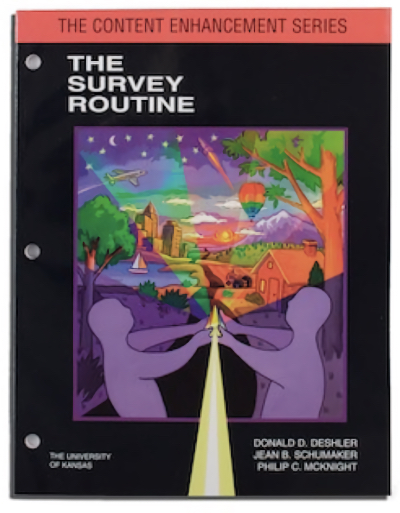The Survey Routine

Teachers use the Survey Routine to construct an overview of a reading assignment when students are having difficulty reading and sorting out information from inconsiderate text.
Students whose teachers taught them how to use the Survey Routine had significantly higher overall test scores than when it was not used. All students answered an average of 10% to 15% more test questions correctly in studies with students with LD and those with low, average, and high course grades in grades 7-12.
SIM Mnemonic Created for this Content Enhancement Routine:
TRIMS - to help students sort and summarize information from a reading passage
Author(s):Donald D. Deshler, Jean B. Schumaker, and Philip C. McKnight
Publication and Purchasing Information: University of Kansas, Center for Research on Learning / KU CRL Online Store
Resources:
The Survey Routine Research (.pdf)
Research Articles:
- Lenz, B.K., Bulgren, J.A., & Hudson, P. (1990). Content enhancement: A model for promoting the acquisition of content by individuals with learning disabilities. In T.E. Scruggs & B.Y.L. Wong (Eds.), Intervention research in learning disabilities (pp. 122-165). New York: Springer-Verlag. This book chapter discusses information processing and pedagogy for students with learning disabilities, including suggestions for teacher planning and teaching routines such as the Chapter Survey Routine, Concept Teaching Routine, and Assignment Completion Routine.
The Story Behind the Survey Routine from author Don Deshler:
At the beginning of our work at the Institute for Research on Learning Disabilities in the 1970s, we did a descriptive study where we tested the academic skills of two groups of students at the junior high and high school levels: students who had been diagnosed as having learning disabilities (LD), and students who were receiving failing or barely passing grades on their report cards in subject-area classes (low-achievers). We learned that both groups of students had severe reading deficits. The students with LD were reading on average at the fourth-grade level in seventh grade. The low achievers were reading on average at the fifth-grade level in seventh grade. What was even more distressing is that these groups of students did not make progress in reading skills across the remaining grade levels. As twelfth graders, the students with LD were reading at the fourth-grade level, and the low achievers were reading at the fifth-grade level on average. We also analyzed textbooks used in required secondary courses and found that they were written at the students’ grade levels or above. We found, for example, that the most widely used U.S. History textbook was written at the 17+ grade level. We reasoned that students reading at the fourth- and fifth-grade levels were not going to be able to gain much information in textbooks written at these high grade levels.
Since our team had been charged with developing instructional materials and methods that can be used to dramatically improve outcomes for secondary students, we knew that we would have to design methods that would enable students to gain information from their textbooks in their required courses if they were to succeed in those courses. We reasoned that secondary subject-area teachers could introduce chapters in textbooks to students in a way that would provide a preview of the information in each chapter as well as teach students how to gain information from textbook chapters independently. As a result, the Survey Routine was born. It was based on a cognitive reading strategy that we had tested with students in the early years of our work. Through the use of the Survey Routine, subject-area teachers guide students through a series of steps with regard to analyzing and familiarizing themselves with a textbook chapter. The students and teacher simultaneously fill out a graphic organizer related to parts of the chapter, and through several repetitions of the routine, students learn to fill out the organizer themselves so that they can study a chapter independently.
Author's thoughts about Content Enhancement Instruction:
Content Enhancement instruction is one of the few instructional methods that have been shown to be effective through empirical research to produce student improvement in learning and in academic performance at the secondary level in general education classes. Research on the Content Enhancement Routines has consistently shown that the performance of all types of students, including high achievers, normal achievers, low achievers, and students with disabilities, improves when teachers use the routines. The purpose of all the routines is to make instruction in subject-area courses more “learner friendly.” As a result, students are more able to learn and remember the information in their courses.
Teacher Feedback on this Product:
This routine and the other Content Enhancement Routines have been readily adopted by thousands of teachers across the nation. When teachers use this routine, not only do students earn higher scores on their unit tests, they also learn how to approach textbook chapters on their own. They become more independent and more confident as learners.
This manual is available through the KU CRL Shop.
Please note that professional development, coaching, and infrastructure support are essential components to effective implementation of SIM instructional tools and interventions. It is highly recommended that you work with a SIM professional developer. See the SIM Event list for sessions or email simpd@ku.edu to learn more.
An accessible version of the documents on this site will be made available upon request. Please contact the KU CRL Professional Development Research Institute, at simpd@ku.edu to request the document be made available in an accessible format.